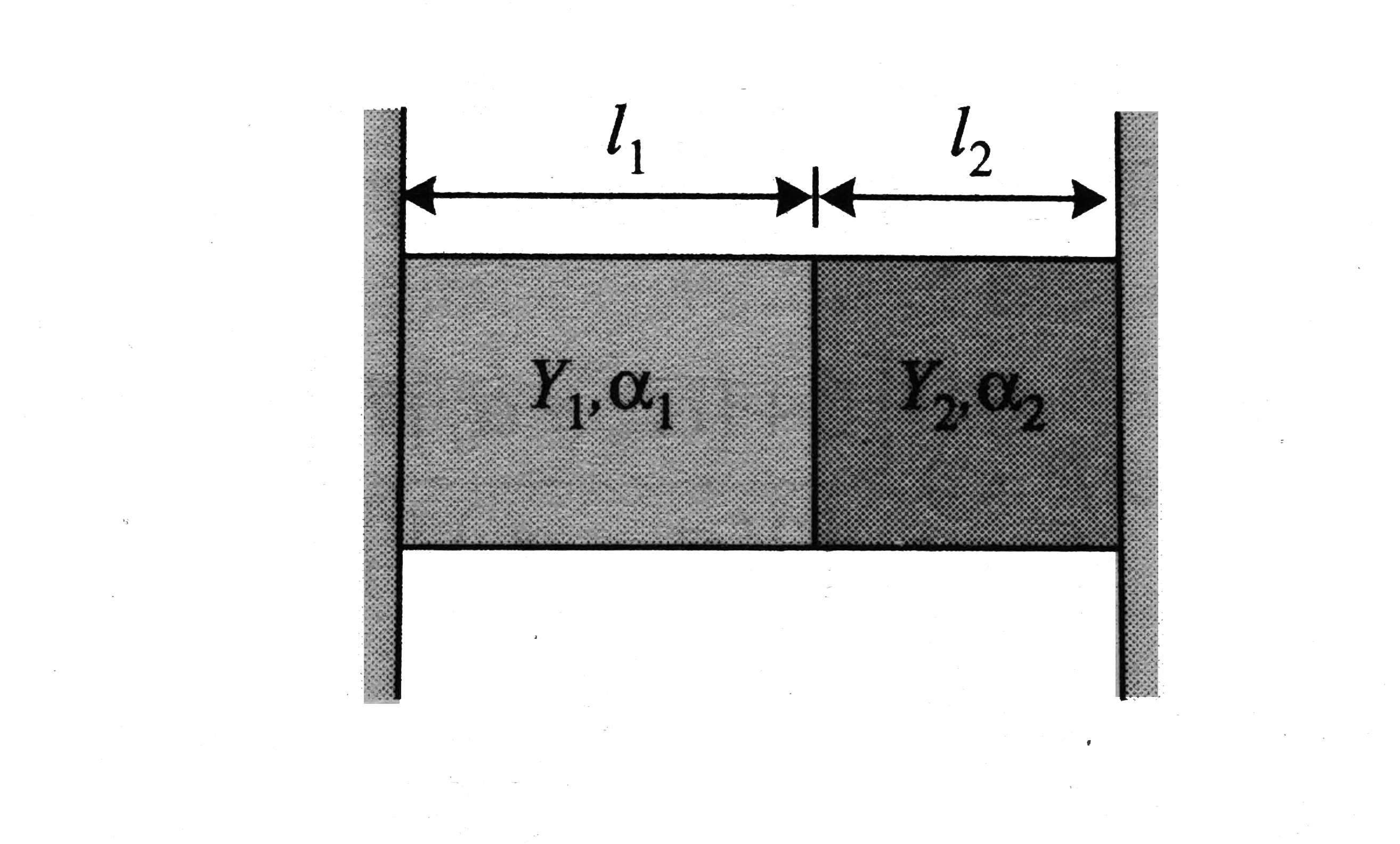Two rods AB and BC of equal cross-sectional area are joined together and clamped between two fixed supports as shown in the figure. For the rod AB and road BC lengths are l1 and l2 coefficient of linear expansion are α1 and α2, young's modulus are Y1 and Y2, densities are ρ1 and ρ2 respectively. Now the temperature of the compound rod is increased by θ. Assume of that there is no significant change in the lengths of rod due to heating. then the time taken by transverse wave pulse to travel from end A to other end C of the compound rod is directly proportional to
_E01_086_Q01.png)
√l2Y1+l1Y2
2√l2Y1+l1Y2
√l1Y2+l2Y1
√l2Y1−l1Y2
The correct Answer is:C
Final length of the rod AB will be
l′1(1+α1θ)−Fl1Y1A
Final length of the rod BC will be
l′2=l2(1+α2θ)−Fl2Y2A
Now, l1+l2=l′1+l′2
⇒FA=(l1α1+l2α2)Y1Y2θlY2+l2Y1
t=i1√FAρ1+i2√FAρ2
It is given that l′1=l1 and l2=l2,
then t∝√l1Y2+l2Y1
Topper's Solved these Questions
- THERMAL PROPERTIES OF MATTERBOOK - NARAYNACHAPTER - THERMAL PROPERTIES OF MATTEREXERCISE - LEVEL - I (H.W.)
22 Videos
- THERMAL PROPERTIES OF MATTERBOOK - NARAYNACHAPTER - THERMAL PROPERTIES OF MATTEREXERCISE - LEVEL - II (H.W.)
19 Videos
- THERMAL PROPERTIES OF MATTERBOOK - NARAYNACHAPTER - THERMAL PROPERTIES OF MATTEREXERCISE - LEVEL - V
12 Videos
- SYSTEM OF PARTICLES AND ROTATIONAL MOTION BOOK - NARAYNACHAPTER - SYSTEM OF PARTICLES AND ROTATIONAL MOTION EXERCISE - EXERCISE - IV
39 Videos
- THERMODYNAMICSBOOK - NARAYNACHAPTER - THERMODYNAMICSEXERCISE - Exercise
187 Videos
Similar Questions
Two rods of length L1 and L2 are made of materials of coefficients of linear expansions α1 an α2 respectively such that L1α1=L2α2. The temperature of the rods is increased by ΔT and correspondingly the change in their respective lengths be ΔL1 and ΔL2
View SolutionTwo rods of different metals having the same area of cross section A are placed between the two massive walls as shown is Fig. The first rod has a length l1, coefficient of linear expansion α1 and Young's modulus Y1. The correcsponding quantities for second rod are l2,α2 and Y2. The temperature of both the rods is now raised by t∘C.
i. Find the force with which the rods act on each other (at higher temperature) in terms of given quantities.
ii. Also find the length of the rods at higher temperature.

View Solution
Knowledge Check
Two metal rods of the same length and area of cross-section are fixed end to end between rigid supports. The materials of the rods have Young module Y1 and Y2 , and coefficient of linear expansion α1 and α2 . The junction between the rod does not shift and the rods are cooled
AY1α1=Y2α1BY1α2=Y2α1CY1α21=Y2α22DY21α1=Y22α2Coefficient of linear expansion of brass and steel rods are α1 and α2. Length of brass and steel rods are l1 and l2 respectively. If (l2−l1) is maintained same at all temperature, which one of the following relations holds good?
Aα1l2=α2l1Bα1l22=α2l21Cα21l2=α2l1Dα1l1=α2l2A thin rod, length L0 at 0∘C and coefficient of linear expansion α has its two ends mintained at temperatures θ1 and θ2 respectively Find its new length .
AL0[1+α(θ1+θ2)]BL0(1+α(θ1+θ22))CL0(1+αθ1)DL0(1+α(θ1+θ22))
The coefficient of linear expansion varies linearly from α1 and α2 in a rod of length l. Find the increase in length when its temperature is increased by ΔT.
View SolutionTwo different wirese having lengths L1 and L2 and respective temperature coefficient of linear expansion α1 and α2 are joined end - to - end . Then the effective temperature coeficient of linear expansion is :
View SolutionCoefficient of linear expansion of brass and steel rods are α1 and α2. Length of brass and steel rods are l1 and l2 respectively. If (l2−l1) is maintained same at all temperature, which one of the following relations holds good?
View SolutionTwo metal rods of lengths L1 and L2 and coefficients of linear expansion α1 and α2 respectively are welded together to make a composite rod of length (L1+L2) at 0∘C. Find the effective coefficient of linear expansion of the composite rod.
View SolutionThe coefficient of linear expansion varies linearly from α1 and α2 in a rod of length l. Find the increase in length when its temperature is increased by ΔT.
View Solution
